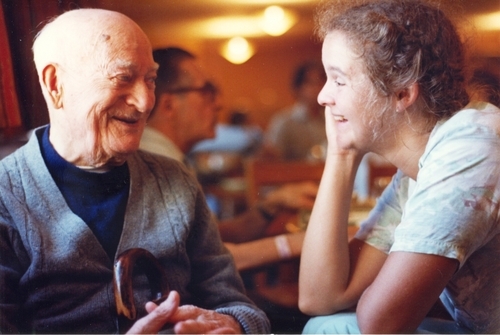Johnson, Henry S.: my Army recollections (July 2, and 7, 1986)
Interviewee: Johnson, Henry S., b. 1917
ABSTRACT: Lieut-.Col. Henry S. Johnson Royal Canadian Corps of Signals Queen's Own Rifles of Canada Johnson_H_0086_01.mp3 Johnson was born in 1917 in Melville, Sask. He followed his older brothers into the Royal Canadian Corps of Signals in 1941. Qualified as a driver-operator and, as such, took considerable wireless training. He was sent to the O.C.T.U. in Debert, N.S. and became attached to an Army Co operation Squadron (R.C.A.F.) to train air crew in wireless communications for operations in support of ground forces. Describes this training and service liaison requirements. Joined 7 Air Liaison Section attached to No. 168 Army Co-operation Squadron in Wainwright, Alta. (1943). It was his duty to see that the required air support was delivered. Air-to-ground communication improved. Overseas in Nov. 1943 he was posted to No. 39 Reconnaissance Wing in Gatwick and became involved in both training and operational roles and the photo interpretation of pictures of suspected V-1 flying bomb sites. Posted to Canadian Army headquarters in Leatherhead he trained army officers in ground support procedures. He returned to No. 143 Wing (Typhoon fighter-bombers) where he was in command of the air support signals unit. He briefed the Air Force on military targets. Most operations were against enemy transportation facilities, in some cases directed to the target by an air liaison officer on the ground. Carried out debriefing of pilots immediately upon their return. Describes the use of advance airport parties required to maintain rapid forward momentum of the ground support squadron. He served with an air wing in the occupation force in Germany. (30:00) Back in Canada as a major he investigated certain substantial shortages in the Ordnance Depot in Regina, which turned out to be largely of an accounting nature. Posted to the Joint Air School in Rivers, Man. in 1946 where continued interservice co-operation was fostered. attached to the Royal Canadian Navy as an army liaison officer. At sea in H.M.C.S. Warrior (light fleet carrier) he trained naval pilots to direct naval gunfire on shore targets and against moving targets at sea. He attended the army staff college in Kingston and offers some details of the work encountered. As staff officer (G.S.O. II) in the Saskatchewan area headquarters he was responsible for training and intelligence. Appointed a company commander in the Queen;s Own Rifles of Canada. (Nominally an infantry officer since 1942). Sent to Korea. His liaison experience was put to good use there in dealing with the U.S. Army. Later appointed to the military plans section of Defence Headquarters. He then became involved in civil defence planning in the Windsor, Ont. area. It was a busy period when the continuity of government was the prime concern. In 1962 posted to the Canadian Defence Liaison Establishment in London, Eng. Relates liaison anecdotes about Korea. During integration/unification he was part of the "Joint Staff" serving the Chief of the Defence Staff. Opinion on unification; loss of esprit de-corps was most serious, but much positive morale has now been recovered. (95:00)
An interview/narrative of Henry S. Johnson's experiences during World War II and the Korean War. Lieutenant-Colonel Johnson served with the Royal Canadian Corps of Signals and the Queen's Own Rifles of Canada. Interview took place on July 2 and 7, 1986.
Interviewer: Aylward, Rick
Rank: Lieutenant-Colonel.
- In Collection:
- 1 sound recording (MP3)
- 51.5, 10.5
- One original sound tape reel (ca. 90 min.) : 1 7/8 ips, 2 track, mono. ; 1 sound cassette copy : standard, mono. in Special Collections.
- Canadian Military Oral History Collection
- JHS_086
- Special Collections Finding Aid: https://search.archives.uvic.ca/reginald-herbert-roy-fonds
- June 13, 2007
- Digital sound recording in .wav format at 16 bits and 22 kHz. In .mp3 format at 64 kbps and 22 kHz. Digitized by AN, technical and cataloguing metadata provided by JF and JP. Transferred from audio reel to audio cassette between 1987-1997. Interview migrated to digital format for UVic Special Collections in 2007. Migration metadata by KD and MT.
- Rights
- This interview has been posted with the understanding that it may be used for research purposes only. Should the interviewee or their heirs have any objections to this interview being accessible on the Internet, it will be removed promptly. Contact UVic Special Collections for permission if using for other than research purposes: speccoll@uvic.ca
- DOI
| Thumbnail | Title | Date Uploaded | Actions |
|---|---|---|---|
|
|
SC141_MilitaryOralHistory_GenericThumbnail |
|
|

|
Johnson_H_0086_01.mp3 |
|